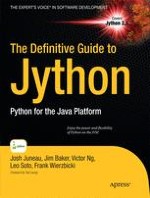Jython is an open source implementation of the high-level, dynamic, object-oriented scripting language Python seamlessly integrated with the Java platform. The predecessor to Jython, JPython, is certified as 100% Pure Java. Jython is freely available for both commercial and noncommercial use and is distributed with source code. Jython is complementary to Java.
The Definitive Guide to Jython, written by the official Jython team leads, covers Jython 2.5 (or 2.5.x)—from the basics to more advanced features. This book begins with a brief introduction to the language and then journeys through Jython’s different features and uses.
The Definitive Guide to Jython is organized for beginners as well as advanced users of the language. The book provides a general overview of the Jython language itself, but it also includes intermediate and advanced topics regarding database, web, and graphical user interface (GUI) applications; Web services/SOA; and integration, concurrency, and parallelism, to name a few.
